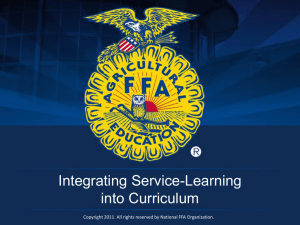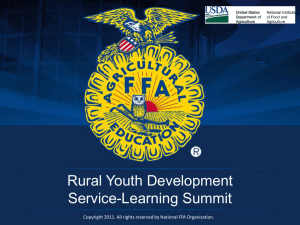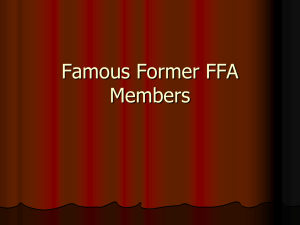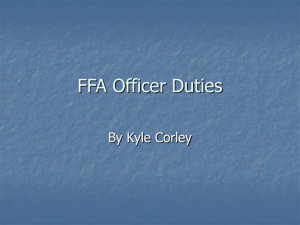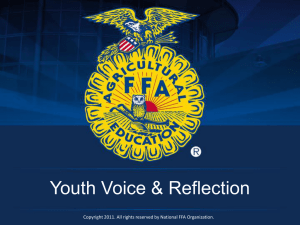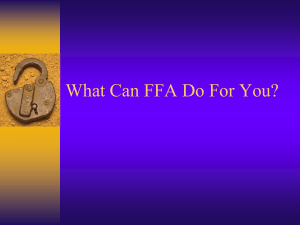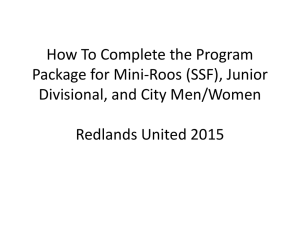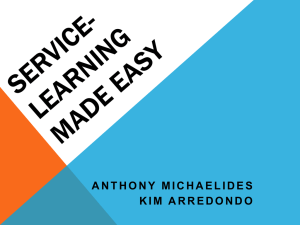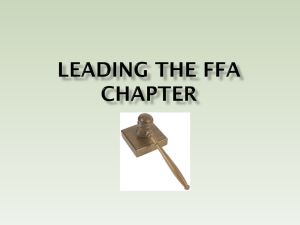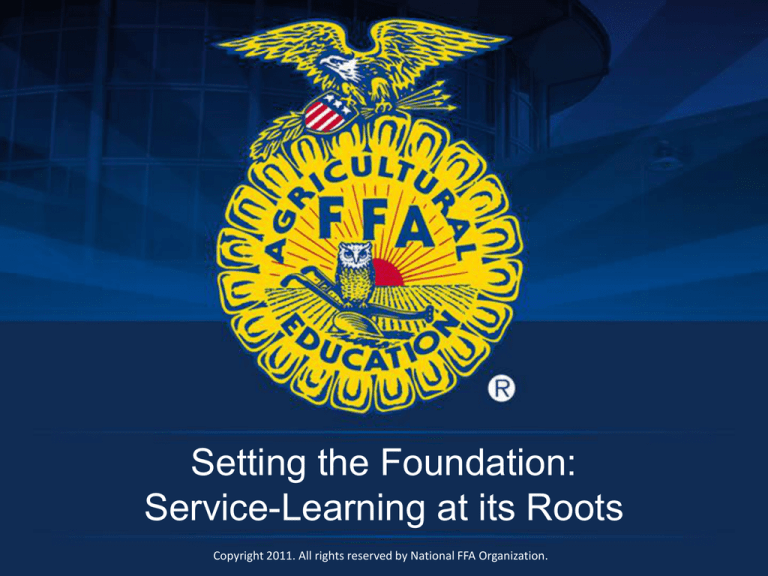
Setting the Foundation:
Service-Learning at its Roots
Copyright 2011. All rights reserved by National FFA Organization.
Objectives
• Understand the differences between
community service, experiential learning
and service-learning.
• Learn the key elements of a servicelearning project.
• Understand the steps to developing and
implementing a service-learning project.
Copyright 2011. All rights reserved by National FFA Organization.
What is it?
As a table, decide if the
scenarios are community
service, experiential learning
or service-learning. You will
have 5 minutes.
Copyright 2011. All rights reserved by National FFA Organization.
Similarities & Differences
Service-Learning
Community Service
Experiential Learning
Tied to Academics
NOT tied to Academics
Tied to Academics
Occurs over months or
Year
Often occurs only once
May happen once or
over the course of time
Structured reflection
No structured
reflection
Structured reflection
Youth Voice present
Often planned by
agency
Some Youth Voice
present
Focus on meeting a
community need
Meets a need
Focus is not meeting a
community need
Completed as a group
Completed as an
individual or group
Completed as an
individual or group
Copyright 2011. All rights reserved by National FFA Organization.
Service-Learning Key Elements
•
•
•
•
•
•
•
•
Meaningful Service
Link to Curriculum
Reflection
Diversity
Youth Voice
Partnerships
Progress Monitoring
Duration and Intensity
Copyright 2011. All rights reserved by National FFA Organization.
Revisit Scenarios
Each table will now have 4 minutes
to discuss how they could turn
their assigned scenario into
service-learning. Be prepared to
report out to the whole group.
Copyright 2011. All rights reserved by National FFA Organization.
Service-Learning I-P-A-R-D Model
5 Steps Investigation
Planning & Preparation
Action
Reflection
Demonstration
Copyright 2011. All rights reserved by National FFA Organization.
Investigation
• Teachers and students
investigate the community
issues they may potentially
address.
• Investigation typically involves
some sort of research and
mapping activity.
Copyright 2011. All rights reserved by National FFA Organization.
Types of Needs Assessments
•
•
•
•
Community Mapping
Walk About
Classroom Brainstorming
Informal Research like
reading the newspaper or
internet search
• Community partner
presents a need
• SAE
Copyright 2011. All rights reserved by National FFA Organization.
Planning & Preparation
• Teachers, students, and community
members plan the learning and service
activities, contact community partners
and address the administrative issues
needed for a successful project.
• One of the most important parts (if not
the most important part) of this step is
creating a link to curriculum!
Copyright 2011. All rights reserved by National FFA Organization.
Action
• The “heart” of the project:
engaging in a meaningful
service experience that will
help your students develop
important knowledge,
skills, and attitudes, and
will benefit the community.
The action occurs both in
the classroom and in the
field.
Copyright 2011. All rights reserved by National FFA Organization.
Reflection
Reflection is On-Going
• Pre Reflection: prepares
participants for the project
• Active Reflection: occurs in the
field and requires critical thinking
• Post Reflection: is used as an
evaluation tool
Copyright 2011. All rights reserved by National FFA Organization.
Demonstration
• Participants publicly demonstrate
their knowledge gained and
accomplishments achieved through
the service-learning project.
Copyright 2011. All rights reserved by National FFA Organization.
Ag. Ed. & Service-Learning
ServiceLearning
Copyright 2011. All rights reserved by National FFA Organization.
Benefits of Service-Learning
• Involves ALL students.
• Increases visibility of Ag. Ed. and FFA within
the school and community.
o “The exposure is helping the school see that we (FFA &
Ag. Ed.) are extremely valuable and should not be cut
out of the school academic program because of budget
cuts.” – Advisor from PA
• Allows Ag. teachers to create cross
curriculum partnerships.
• Creates SAE opportunities.
• Opportunities for financial support.
Copyright 2011. All rights reserved by National FFA Organization.
Note About Dinner
• Please sit as states (if possible).
• We will also have a table for
individual chapters.
• Use this time to discuss what you
would like to gain from this
training.
Copyright 2011. All rights reserved by National FFA Organization.

